Cardiovascular System | Essay
VerifiedAdded on 2022/08/22
|8
|2005
|23
AI Summary
Contribute Materials
Your contribution can guide someone’s learning journey. Share your
documents today.
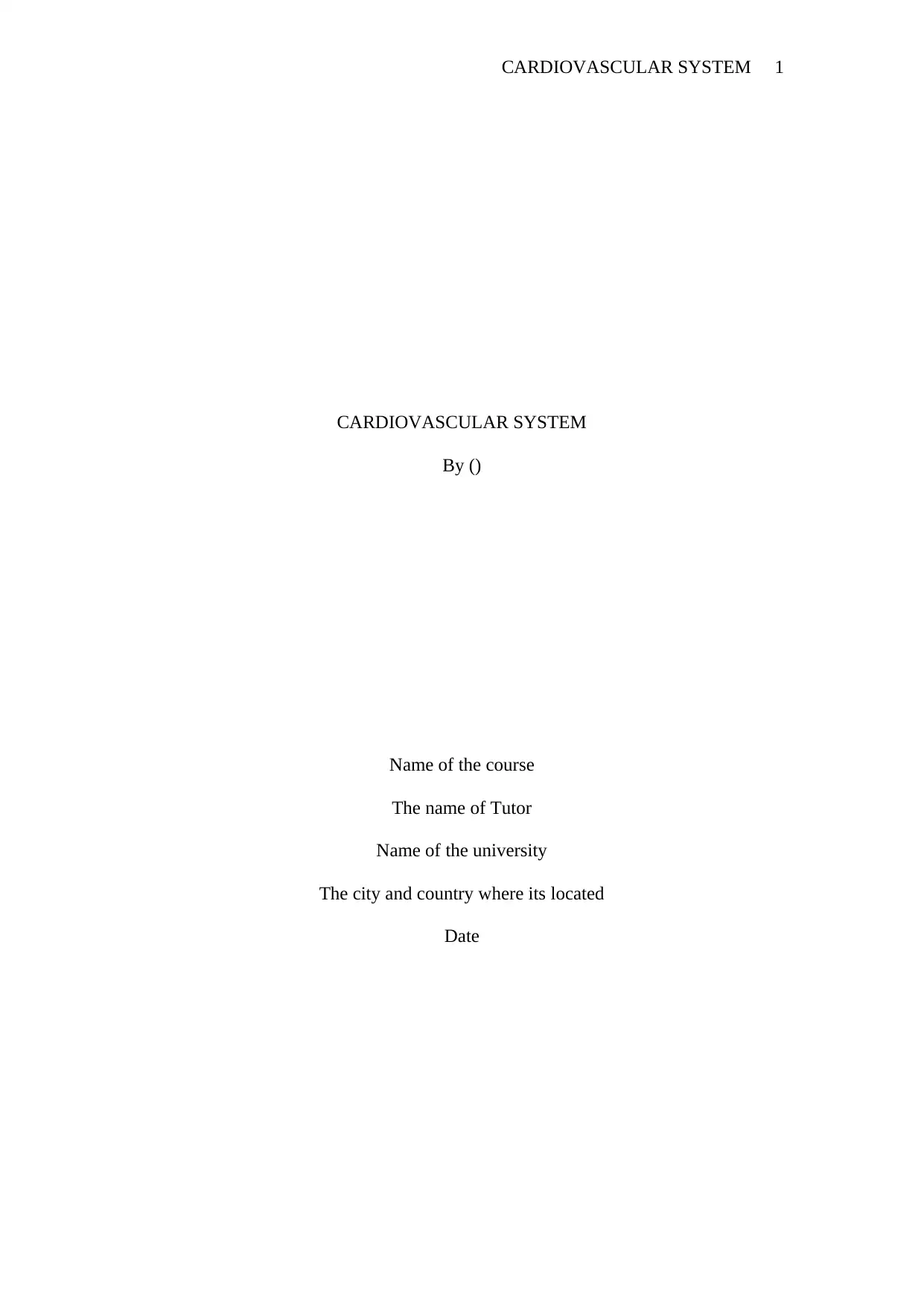
CARDIOVASCULAR SYSTEM 1
CARDIOVASCULAR SYSTEM
By ()
Name of the course
The name of Tutor
Name of the university
The city and country where its located
Date
CARDIOVASCULAR SYSTEM
By ()
Name of the course
The name of Tutor
Name of the university
The city and country where its located
Date
Secure Best Marks with AI Grader
Need help grading? Try our AI Grader for instant feedback on your assignments.
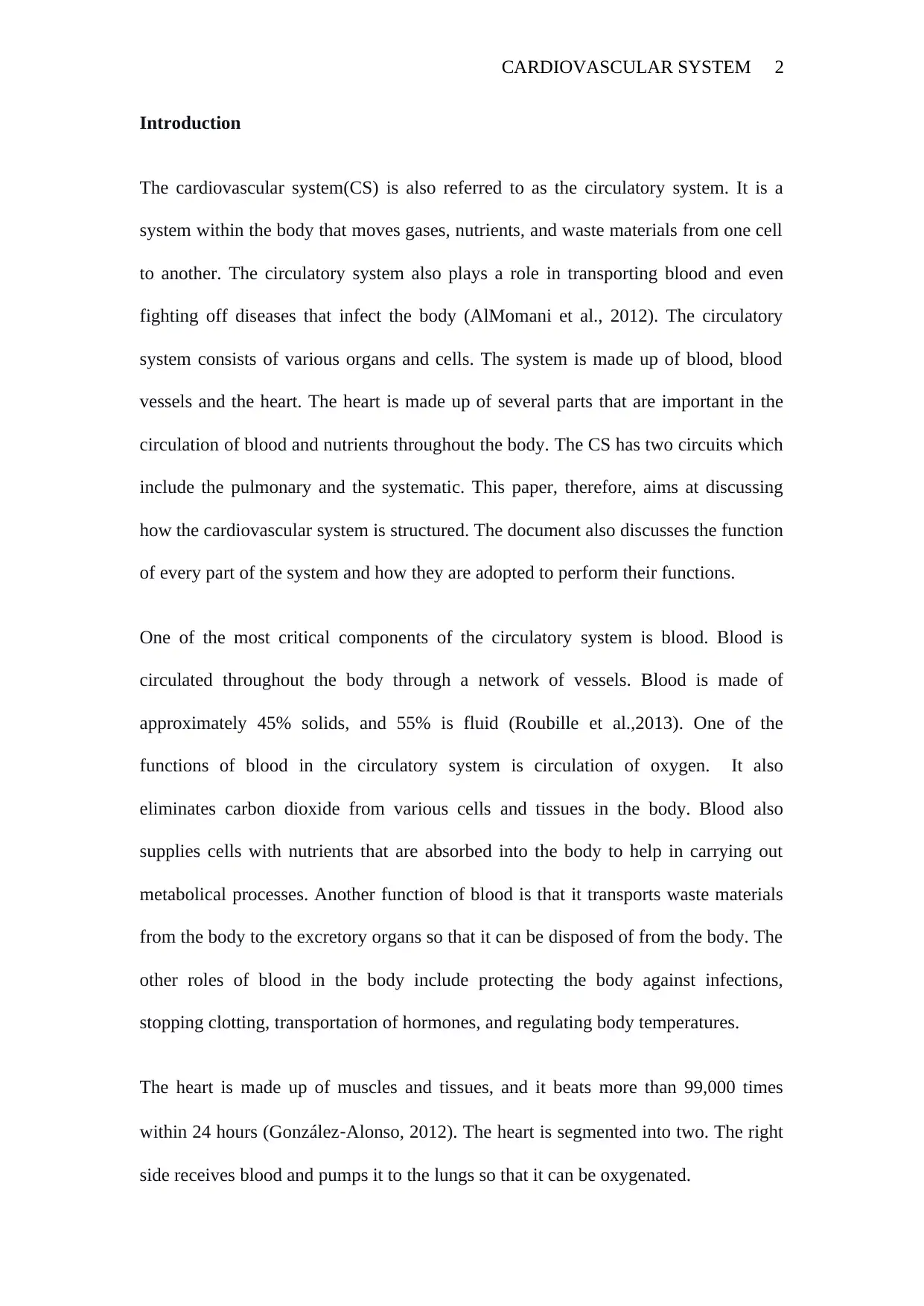
CARDIOVASCULAR SYSTEM 2
Introduction
The cardiovascular system(CS) is also referred to as the circulatory system. It is a
system within the body that moves gases, nutrients, and waste materials from one cell
to another. The circulatory system also plays a role in transporting blood and even
fighting off diseases that infect the body (AlMomani et al., 2012). The circulatory
system consists of various organs and cells. The system is made up of blood, blood
vessels and the heart. The heart is made up of several parts that are important in the
circulation of blood and nutrients throughout the body. The CS has two circuits which
include the pulmonary and the systematic. This paper, therefore, aims at discussing
how the cardiovascular system is structured. The document also discusses the function
of every part of the system and how they are adopted to perform their functions.
One of the most critical components of the circulatory system is blood. Blood is
circulated throughout the body through a network of vessels. Blood is made of
approximately 45% solids, and 55% is fluid (Roubille et al.,2013). One of the
functions of blood in the circulatory system is circulation of oxygen. It also
eliminates carbon dioxide from various cells and tissues in the body. Blood also
supplies cells with nutrients that are absorbed into the body to help in carrying out
metabolical processes. Another function of blood is that it transports waste materials
from the body to the excretory organs so that it can be disposed of from the body. The
other roles of blood in the body include protecting the body against infections,
stopping clotting, transportation of hormones, and regulating body temperatures.
The heart is made up of muscles and tissues, and it beats more than 99,000 times
within 24 hours (González‐Alonso, 2012). The heart is segmented into two. The right
side receives blood and pumps it to the lungs so that it can be oxygenated.
Introduction
The cardiovascular system(CS) is also referred to as the circulatory system. It is a
system within the body that moves gases, nutrients, and waste materials from one cell
to another. The circulatory system also plays a role in transporting blood and even
fighting off diseases that infect the body (AlMomani et al., 2012). The circulatory
system consists of various organs and cells. The system is made up of blood, blood
vessels and the heart. The heart is made up of several parts that are important in the
circulation of blood and nutrients throughout the body. The CS has two circuits which
include the pulmonary and the systematic. This paper, therefore, aims at discussing
how the cardiovascular system is structured. The document also discusses the function
of every part of the system and how they are adopted to perform their functions.
One of the most critical components of the circulatory system is blood. Blood is
circulated throughout the body through a network of vessels. Blood is made of
approximately 45% solids, and 55% is fluid (Roubille et al.,2013). One of the
functions of blood in the circulatory system is circulation of oxygen. It also
eliminates carbon dioxide from various cells and tissues in the body. Blood also
supplies cells with nutrients that are absorbed into the body to help in carrying out
metabolical processes. Another function of blood is that it transports waste materials
from the body to the excretory organs so that it can be disposed of from the body. The
other roles of blood in the body include protecting the body against infections,
stopping clotting, transportation of hormones, and regulating body temperatures.
The heart is made up of muscles and tissues, and it beats more than 99,000 times
within 24 hours (González‐Alonso, 2012). The heart is segmented into two. The right
side receives blood and pumps it to the lungs so that it can be oxygenated.
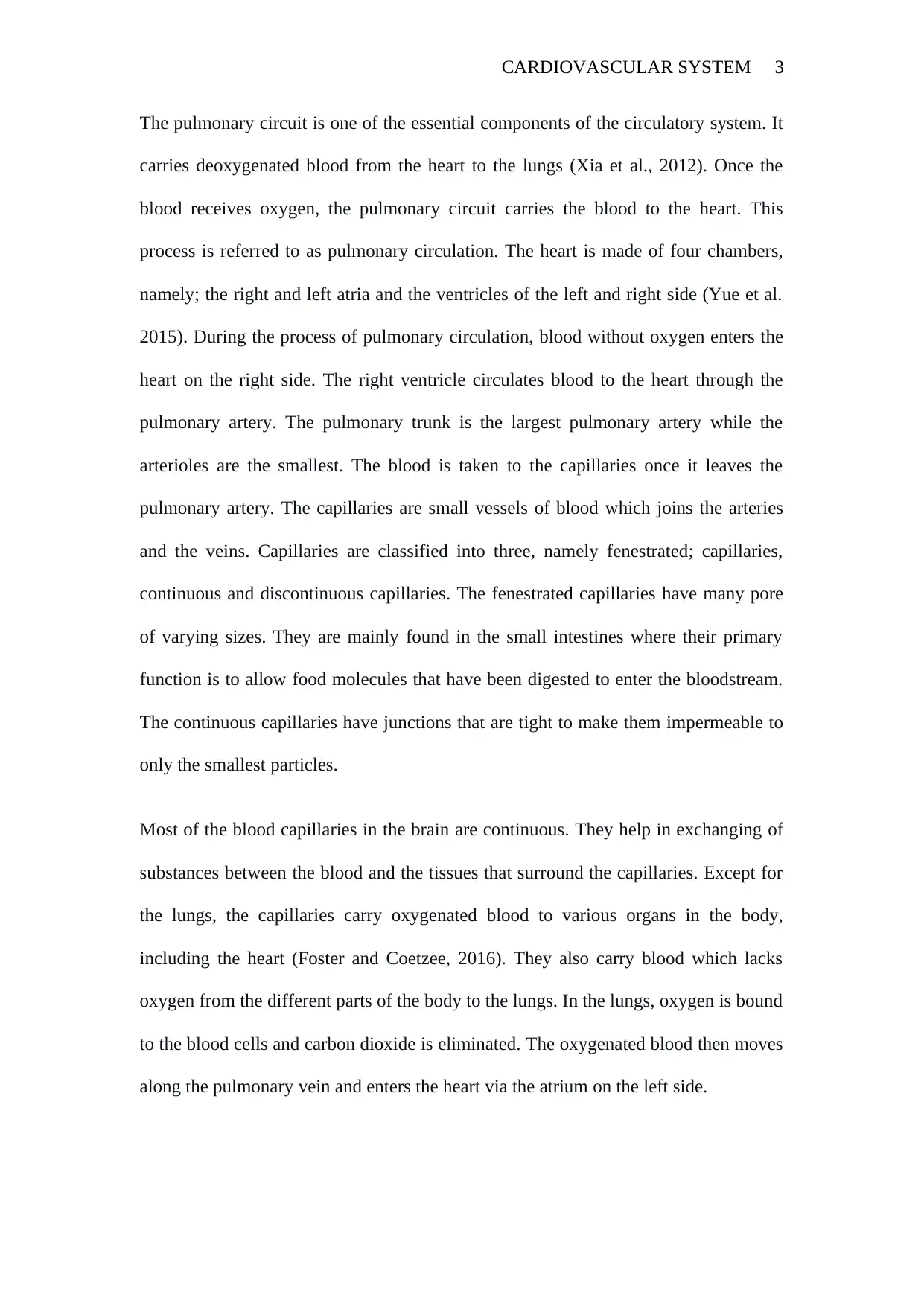
CARDIOVASCULAR SYSTEM 3
The pulmonary circuit is one of the essential components of the circulatory system. It
carries deoxygenated blood from the heart to the lungs (Xia et al., 2012). Once the
blood receives oxygen, the pulmonary circuit carries the blood to the heart. This
process is referred to as pulmonary circulation. The heart is made of four chambers,
namely; the right and left atria and the ventricles of the left and right side (Yue et al.
2015). During the process of pulmonary circulation, blood without oxygen enters the
heart on the right side. The right ventricle circulates blood to the heart through the
pulmonary artery. The pulmonary trunk is the largest pulmonary artery while the
arterioles are the smallest. The blood is taken to the capillaries once it leaves the
pulmonary artery. The capillaries are small vessels of blood which joins the arteries
and the veins. Capillaries are classified into three, namely fenestrated; capillaries,
continuous and discontinuous capillaries. The fenestrated capillaries have many pore
of varying sizes. They are mainly found in the small intestines where their primary
function is to allow food molecules that have been digested to enter the bloodstream.
The continuous capillaries have junctions that are tight to make them impermeable to
only the smallest particles.
Most of the blood capillaries in the brain are continuous. They help in exchanging of
substances between the blood and the tissues that surround the capillaries. Except for
the lungs, the capillaries carry oxygenated blood to various organs in the body,
including the heart (Foster and Coetzee, 2016). They also carry blood which lacks
oxygen from the different parts of the body to the lungs. In the lungs, oxygen is bound
to the blood cells and carbon dioxide is eliminated. The oxygenated blood then moves
along the pulmonary vein and enters the heart via the atrium on the left side.
The pulmonary circuit is one of the essential components of the circulatory system. It
carries deoxygenated blood from the heart to the lungs (Xia et al., 2012). Once the
blood receives oxygen, the pulmonary circuit carries the blood to the heart. This
process is referred to as pulmonary circulation. The heart is made of four chambers,
namely; the right and left atria and the ventricles of the left and right side (Yue et al.
2015). During the process of pulmonary circulation, blood without oxygen enters the
heart on the right side. The right ventricle circulates blood to the heart through the
pulmonary artery. The pulmonary trunk is the largest pulmonary artery while the
arterioles are the smallest. The blood is taken to the capillaries once it leaves the
pulmonary artery. The capillaries are small vessels of blood which joins the arteries
and the veins. Capillaries are classified into three, namely fenestrated; capillaries,
continuous and discontinuous capillaries. The fenestrated capillaries have many pore
of varying sizes. They are mainly found in the small intestines where their primary
function is to allow food molecules that have been digested to enter the bloodstream.
The continuous capillaries have junctions that are tight to make them impermeable to
only the smallest particles.
Most of the blood capillaries in the brain are continuous. They help in exchanging of
substances between the blood and the tissues that surround the capillaries. Except for
the lungs, the capillaries carry oxygenated blood to various organs in the body,
including the heart (Foster and Coetzee, 2016). They also carry blood which lacks
oxygen from the different parts of the body to the lungs. In the lungs, oxygen is bound
to the blood cells and carbon dioxide is eliminated. The oxygenated blood then moves
along the pulmonary vein and enters the heart via the atrium on the left side.
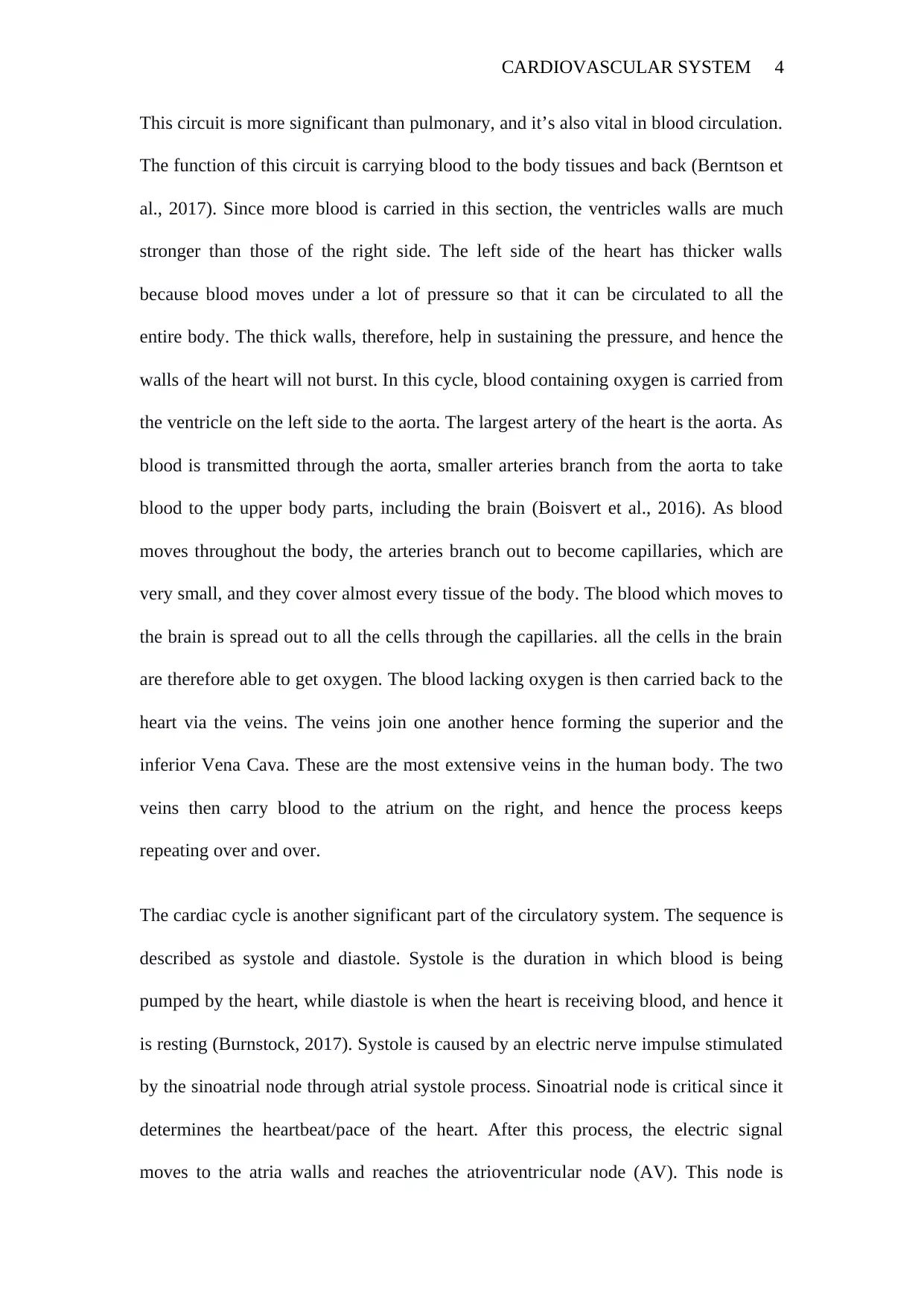
CARDIOVASCULAR SYSTEM 4
This circuit is more significant than pulmonary, and it’s also vital in blood circulation.
The function of this circuit is carrying blood to the body tissues and back (Berntson et
al., 2017). Since more blood is carried in this section, the ventricles walls are much
stronger than those of the right side. The left side of the heart has thicker walls
because blood moves under a lot of pressure so that it can be circulated to all the
entire body. The thick walls, therefore, help in sustaining the pressure, and hence the
walls of the heart will not burst. In this cycle, blood containing oxygen is carried from
the ventricle on the left side to the aorta. The largest artery of the heart is the aorta. As
blood is transmitted through the aorta, smaller arteries branch from the aorta to take
blood to the upper body parts, including the brain (Boisvert et al., 2016). As blood
moves throughout the body, the arteries branch out to become capillaries, which are
very small, and they cover almost every tissue of the body. The blood which moves to
the brain is spread out to all the cells through the capillaries. all the cells in the brain
are therefore able to get oxygen. The blood lacking oxygen is then carried back to the
heart via the veins. The veins join one another hence forming the superior and the
inferior Vena Cava. These are the most extensive veins in the human body. The two
veins then carry blood to the atrium on the right, and hence the process keeps
repeating over and over.
The cardiac cycle is another significant part of the circulatory system. The sequence is
described as systole and diastole. Systole is the duration in which blood is being
pumped by the heart, while diastole is when the heart is receiving blood, and hence it
is resting (Burnstock, 2017). Systole is caused by an electric nerve impulse stimulated
by the sinoatrial node through atrial systole process. Sinoatrial node is critical since it
determines the heartbeat/pace of the heart. After this process, the electric signal
moves to the atria walls and reaches the atrioventricular node (AV). This node is
This circuit is more significant than pulmonary, and it’s also vital in blood circulation.
The function of this circuit is carrying blood to the body tissues and back (Berntson et
al., 2017). Since more blood is carried in this section, the ventricles walls are much
stronger than those of the right side. The left side of the heart has thicker walls
because blood moves under a lot of pressure so that it can be circulated to all the
entire body. The thick walls, therefore, help in sustaining the pressure, and hence the
walls of the heart will not burst. In this cycle, blood containing oxygen is carried from
the ventricle on the left side to the aorta. The largest artery of the heart is the aorta. As
blood is transmitted through the aorta, smaller arteries branch from the aorta to take
blood to the upper body parts, including the brain (Boisvert et al., 2016). As blood
moves throughout the body, the arteries branch out to become capillaries, which are
very small, and they cover almost every tissue of the body. The blood which moves to
the brain is spread out to all the cells through the capillaries. all the cells in the brain
are therefore able to get oxygen. The blood lacking oxygen is then carried back to the
heart via the veins. The veins join one another hence forming the superior and the
inferior Vena Cava. These are the most extensive veins in the human body. The two
veins then carry blood to the atrium on the right, and hence the process keeps
repeating over and over.
The cardiac cycle is another significant part of the circulatory system. The sequence is
described as systole and diastole. Systole is the duration in which blood is being
pumped by the heart, while diastole is when the heart is receiving blood, and hence it
is resting (Burnstock, 2017). Systole is caused by an electric nerve impulse stimulated
by the sinoatrial node through atrial systole process. Sinoatrial node is critical since it
determines the heartbeat/pace of the heart. After this process, the electric signal
moves to the atria walls and reaches the atrioventricular node (AV). This node is
Secure Best Marks with AI Grader
Need help grading? Try our AI Grader for instant feedback on your assignments.
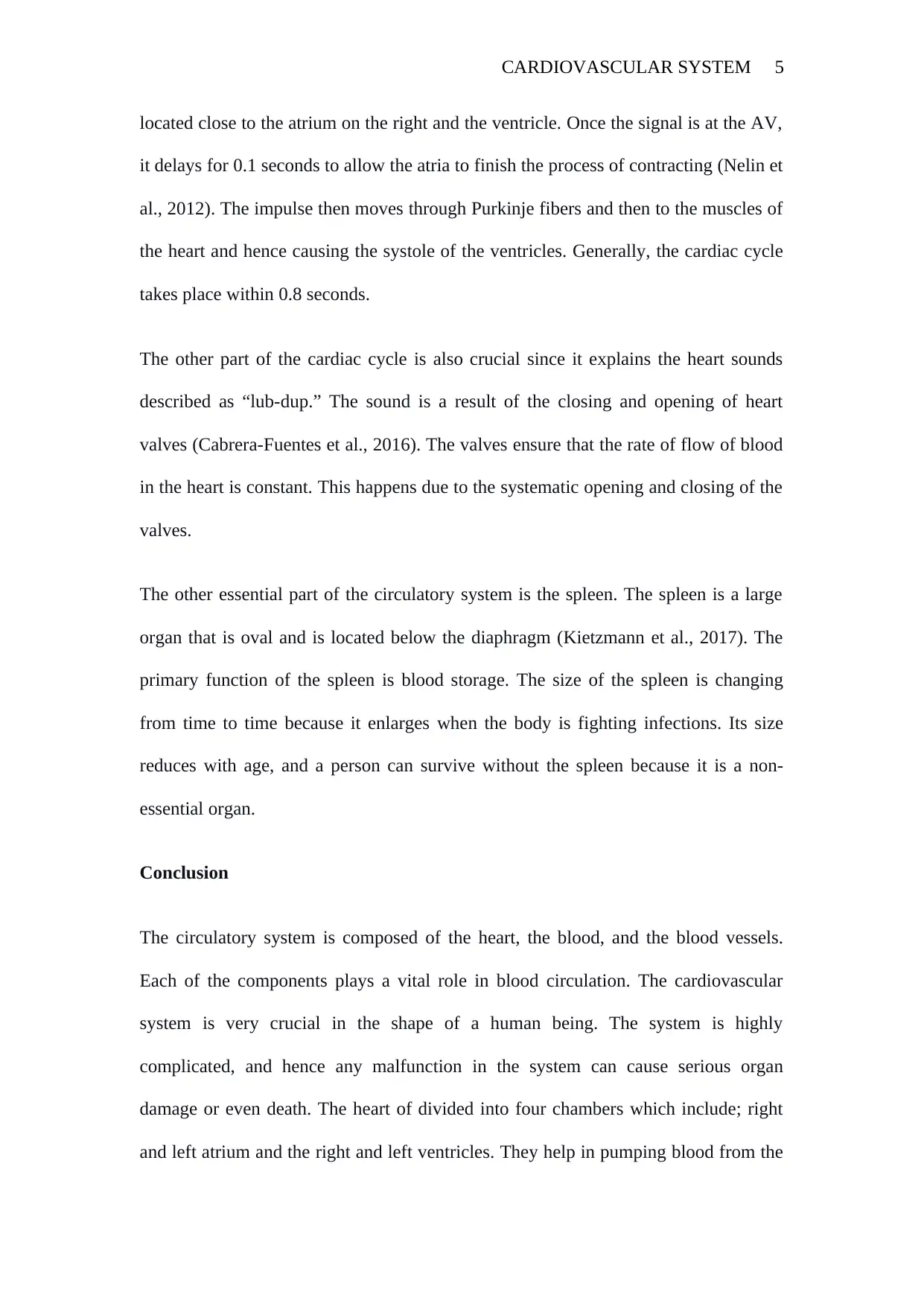
CARDIOVASCULAR SYSTEM 5
located close to the atrium on the right and the ventricle. Once the signal is at the AV,
it delays for 0.1 seconds to allow the atria to finish the process of contracting (Nelin et
al., 2012). The impulse then moves through Purkinje fibers and then to the muscles of
the heart and hence causing the systole of the ventricles. Generally, the cardiac cycle
takes place within 0.8 seconds.
The other part of the cardiac cycle is also crucial since it explains the heart sounds
described as “lub-dup.” The sound is a result of the closing and opening of heart
valves (Cabrera-Fuentes et al., 2016). The valves ensure that the rate of flow of blood
in the heart is constant. This happens due to the systematic opening and closing of the
valves.
The other essential part of the circulatory system is the spleen. The spleen is a large
organ that is oval and is located below the diaphragm (Kietzmann et al., 2017). The
primary function of the spleen is blood storage. The size of the spleen is changing
from time to time because it enlarges when the body is fighting infections. Its size
reduces with age, and a person can survive without the spleen because it is a non-
essential organ.
Conclusion
The circulatory system is composed of the heart, the blood, and the blood vessels.
Each of the components plays a vital role in blood circulation. The cardiovascular
system is very crucial in the shape of a human being. The system is highly
complicated, and hence any malfunction in the system can cause serious organ
damage or even death. The heart of divided into four chambers which include; right
and left atrium and the right and left ventricles. They help in pumping blood from the
located close to the atrium on the right and the ventricle. Once the signal is at the AV,
it delays for 0.1 seconds to allow the atria to finish the process of contracting (Nelin et
al., 2012). The impulse then moves through Purkinje fibers and then to the muscles of
the heart and hence causing the systole of the ventricles. Generally, the cardiac cycle
takes place within 0.8 seconds.
The other part of the cardiac cycle is also crucial since it explains the heart sounds
described as “lub-dup.” The sound is a result of the closing and opening of heart
valves (Cabrera-Fuentes et al., 2016). The valves ensure that the rate of flow of blood
in the heart is constant. This happens due to the systematic opening and closing of the
valves.
The other essential part of the circulatory system is the spleen. The spleen is a large
organ that is oval and is located below the diaphragm (Kietzmann et al., 2017). The
primary function of the spleen is blood storage. The size of the spleen is changing
from time to time because it enlarges when the body is fighting infections. Its size
reduces with age, and a person can survive without the spleen because it is a non-
essential organ.
Conclusion
The circulatory system is composed of the heart, the blood, and the blood vessels.
Each of the components plays a vital role in blood circulation. The cardiovascular
system is very crucial in the shape of a human being. The system is highly
complicated, and hence any malfunction in the system can cause serious organ
damage or even death. The heart of divided into four chambers which include; right
and left atrium and the right and left ventricles. They help in pumping blood from the
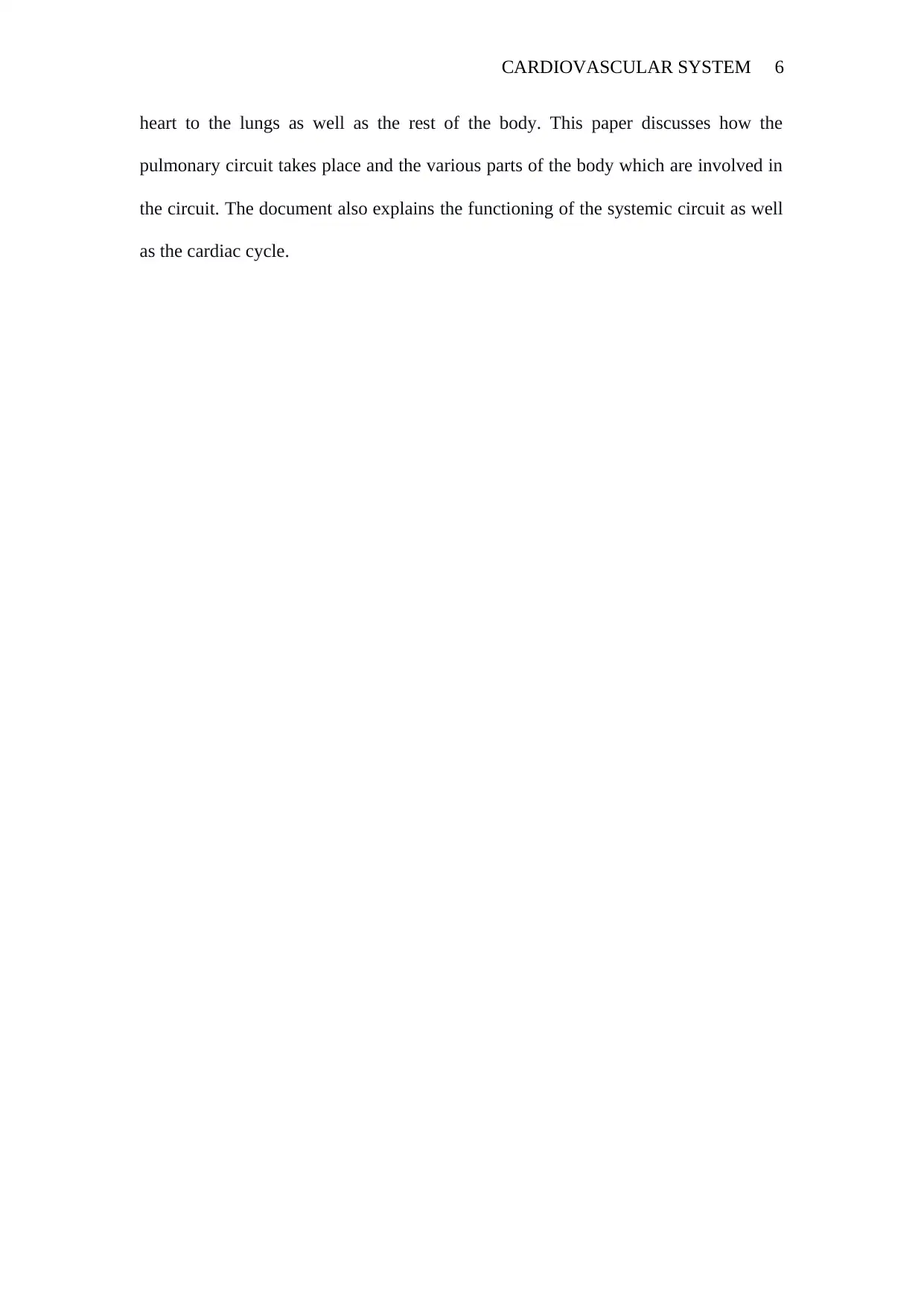
CARDIOVASCULAR SYSTEM 6
heart to the lungs as well as the rest of the body. This paper discusses how the
pulmonary circuit takes place and the various parts of the body which are involved in
the circuit. The document also explains the functioning of the systemic circuit as well
as the cardiac cycle.
heart to the lungs as well as the rest of the body. This paper discusses how the
pulmonary circuit takes place and the various parts of the body which are involved in
the circuit. The document also explains the functioning of the systemic circuit as well
as the cardiac cycle.
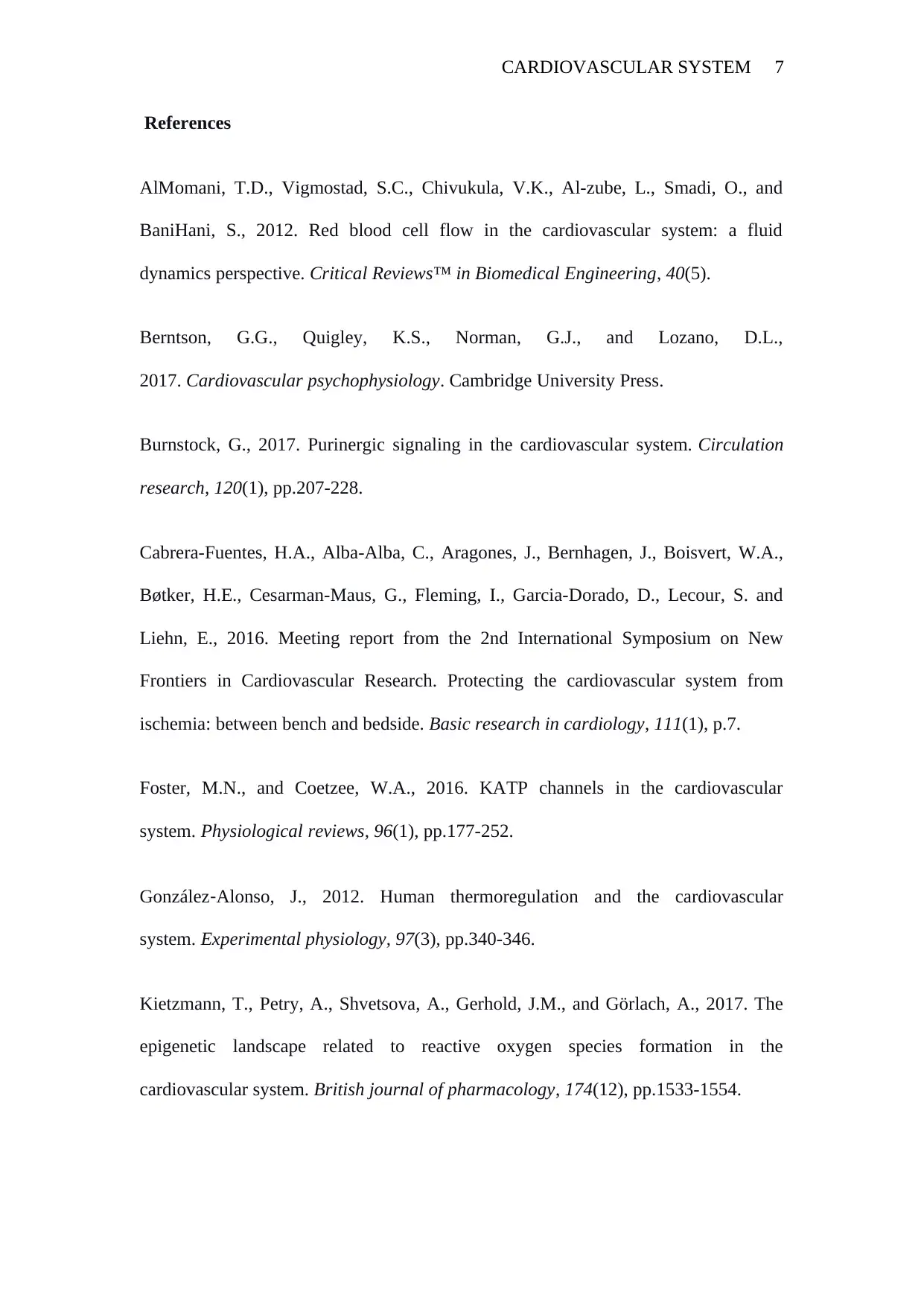
CARDIOVASCULAR SYSTEM 7
References
AlMomani, T.D., Vigmostad, S.C., Chivukula, V.K., Al-zube, L., Smadi, O., and
BaniHani, S., 2012. Red blood cell flow in the cardiovascular system: a fluid
dynamics perspective. Critical Reviews™ in Biomedical Engineering, 40(5).
Berntson, G.G., Quigley, K.S., Norman, G.J., and Lozano, D.L.,
2017. Cardiovascular psychophysiology. Cambridge University Press.
Burnstock, G., 2017. Purinergic signaling in the cardiovascular system. Circulation
research, 120(1), pp.207-228.
Cabrera-Fuentes, H.A., Alba-Alba, C., Aragones, J., Bernhagen, J., Boisvert, W.A.,
Bøtker, H.E., Cesarman-Maus, G., Fleming, I., Garcia-Dorado, D., Lecour, S. and
Liehn, E., 2016. Meeting report from the 2nd International Symposium on New
Frontiers in Cardiovascular Research. Protecting the cardiovascular system from
ischemia: between bench and bedside. Basic research in cardiology, 111(1), p.7.
Foster, M.N., and Coetzee, W.A., 2016. KATP channels in the cardiovascular
system. Physiological reviews, 96(1), pp.177-252.
González‐Alonso, J., 2012. Human thermoregulation and the cardiovascular
system. Experimental physiology, 97(3), pp.340-346.
Kietzmann, T., Petry, A., Shvetsova, A., Gerhold, J.M., and Görlach, A., 2017. The
epigenetic landscape related to reactive oxygen species formation in the
cardiovascular system. British journal of pharmacology, 174(12), pp.1533-1554.
References
AlMomani, T.D., Vigmostad, S.C., Chivukula, V.K., Al-zube, L., Smadi, O., and
BaniHani, S., 2012. Red blood cell flow in the cardiovascular system: a fluid
dynamics perspective. Critical Reviews™ in Biomedical Engineering, 40(5).
Berntson, G.G., Quigley, K.S., Norman, G.J., and Lozano, D.L.,
2017. Cardiovascular psychophysiology. Cambridge University Press.
Burnstock, G., 2017. Purinergic signaling in the cardiovascular system. Circulation
research, 120(1), pp.207-228.
Cabrera-Fuentes, H.A., Alba-Alba, C., Aragones, J., Bernhagen, J., Boisvert, W.A.,
Bøtker, H.E., Cesarman-Maus, G., Fleming, I., Garcia-Dorado, D., Lecour, S. and
Liehn, E., 2016. Meeting report from the 2nd International Symposium on New
Frontiers in Cardiovascular Research. Protecting the cardiovascular system from
ischemia: between bench and bedside. Basic research in cardiology, 111(1), p.7.
Foster, M.N., and Coetzee, W.A., 2016. KATP channels in the cardiovascular
system. Physiological reviews, 96(1), pp.177-252.
González‐Alonso, J., 2012. Human thermoregulation and the cardiovascular
system. Experimental physiology, 97(3), pp.340-346.
Kietzmann, T., Petry, A., Shvetsova, A., Gerhold, J.M., and Görlach, A., 2017. The
epigenetic landscape related to reactive oxygen species formation in the
cardiovascular system. British journal of pharmacology, 174(12), pp.1533-1554.
Paraphrase This Document
Need a fresh take? Get an instant paraphrase of this document with our AI Paraphraser
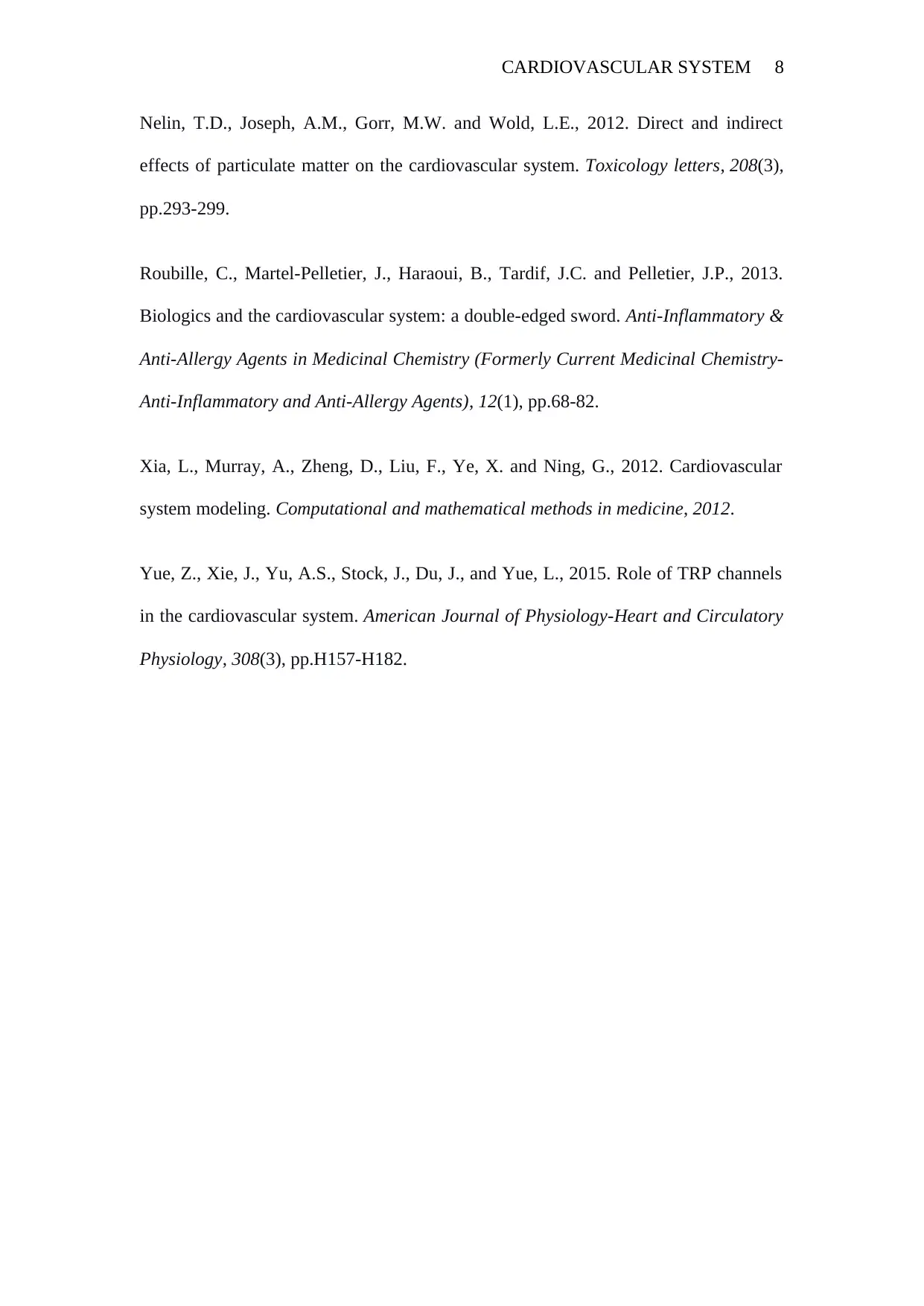
CARDIOVASCULAR SYSTEM 8
Nelin, T.D., Joseph, A.M., Gorr, M.W. and Wold, L.E., 2012. Direct and indirect
effects of particulate matter on the cardiovascular system. Toxicology letters, 208(3),
pp.293-299.
Roubille, C., Martel-Pelletier, J., Haraoui, B., Tardif, J.C. and Pelletier, J.P., 2013.
Biologics and the cardiovascular system: a double-edged sword. Anti-Inflammatory &
Anti-Allergy Agents in Medicinal Chemistry (Formerly Current Medicinal Chemistry-
Anti-Inflammatory and Anti-Allergy Agents), 12(1), pp.68-82.
Xia, L., Murray, A., Zheng, D., Liu, F., Ye, X. and Ning, G., 2012. Cardiovascular
system modeling. Computational and mathematical methods in medicine, 2012.
Yue, Z., Xie, J., Yu, A.S., Stock, J., Du, J., and Yue, L., 2015. Role of TRP channels
in the cardiovascular system. American Journal of Physiology-Heart and Circulatory
Physiology, 308(3), pp.H157-H182.
Nelin, T.D., Joseph, A.M., Gorr, M.W. and Wold, L.E., 2012. Direct and indirect
effects of particulate matter on the cardiovascular system. Toxicology letters, 208(3),
pp.293-299.
Roubille, C., Martel-Pelletier, J., Haraoui, B., Tardif, J.C. and Pelletier, J.P., 2013.
Biologics and the cardiovascular system: a double-edged sword. Anti-Inflammatory &
Anti-Allergy Agents in Medicinal Chemistry (Formerly Current Medicinal Chemistry-
Anti-Inflammatory and Anti-Allergy Agents), 12(1), pp.68-82.
Xia, L., Murray, A., Zheng, D., Liu, F., Ye, X. and Ning, G., 2012. Cardiovascular
system modeling. Computational and mathematical methods in medicine, 2012.
Yue, Z., Xie, J., Yu, A.S., Stock, J., Du, J., and Yue, L., 2015. Role of TRP channels
in the cardiovascular system. American Journal of Physiology-Heart and Circulatory
Physiology, 308(3), pp.H157-H182.
1 out of 8
Related Documents
Your All-in-One AI-Powered Toolkit for Academic Success.
+13062052269
info@desklib.com
Available 24*7 on WhatsApp / Email
![[object Object]](/_next/static/media/star-bottom.7253800d.svg)
Unlock your academic potential
© 2024 | Zucol Services PVT LTD | All rights reserved.





